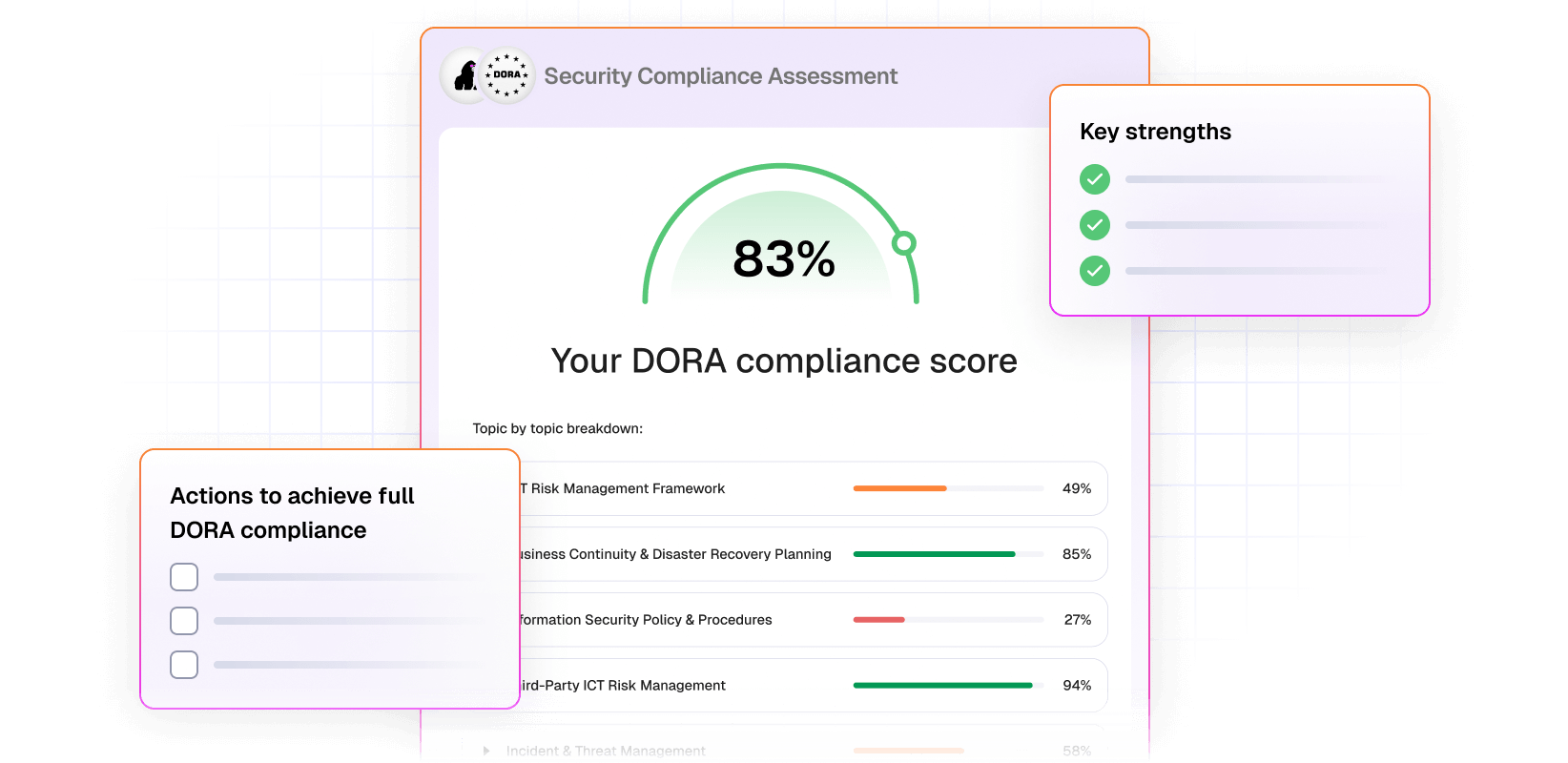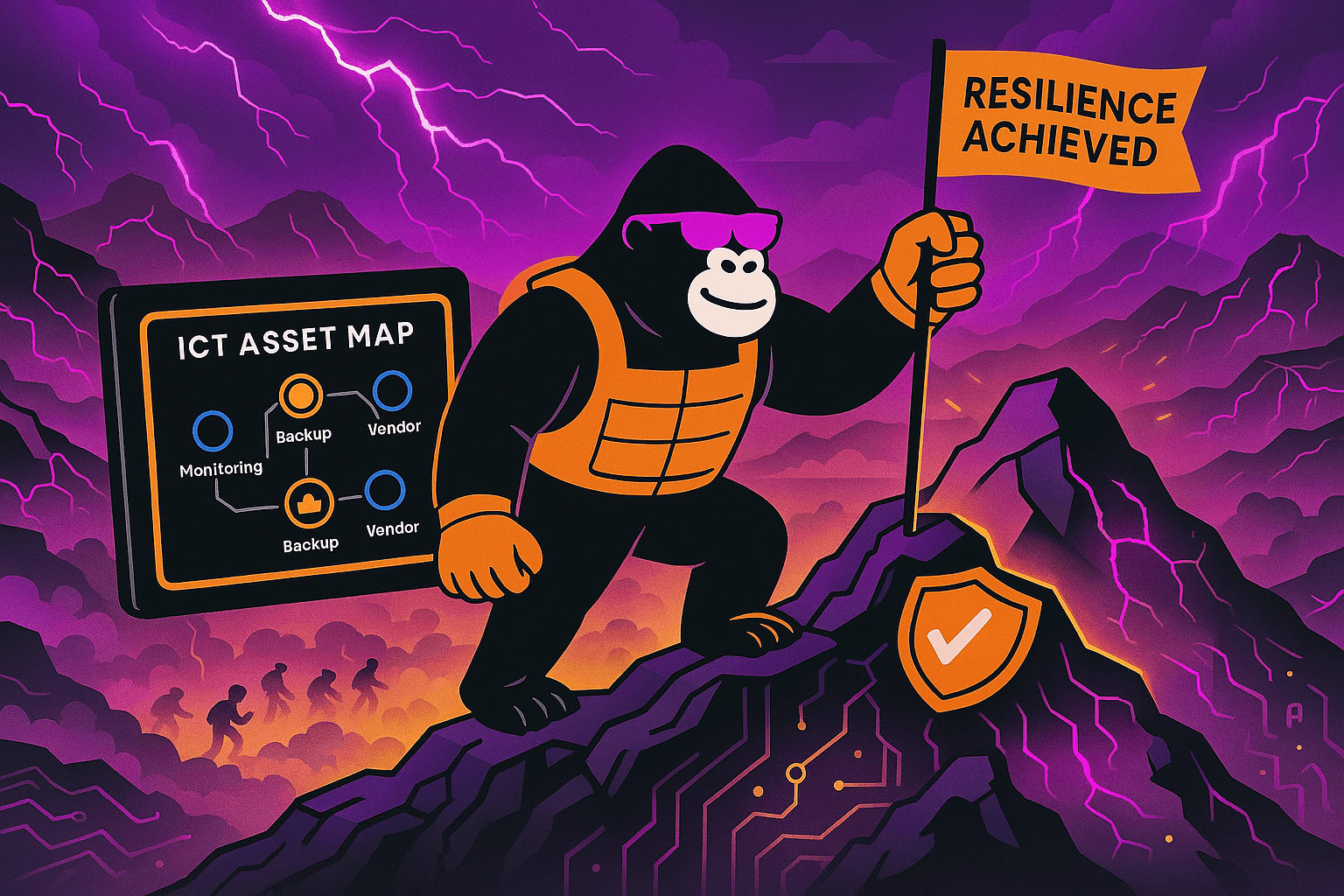When I first met with one of our clients—a mid-sized financial institution struggling with the DORA ICT Risk Management Framework—I could see the stress written all over their team’s faces. They were juggling multiple challenges: fragmented risk management processes, vendor compliance issues, and uncertainty about where to even begin.
DORA can feel overwhelming, but I’ve seen firsthand how organizations can transform their approach to ICT risk management with the right guidance. With a clear roadmap and a commitment to resilience, this client not only met DORA’s requirements but also emerged stronger and more confident. Let me take you through their journey and the lessons of the DORA ICT risk management framework we learned together.

Assess your DORA readiness for free!
Evaluate your organization’s compliance gaps and find areas for improvement—no prior DORA knowledge needed.
Building a strong foundation for ICT risk management
The first thing I noticed about our client’s compliance strategy is they lacked a centralized framework for managing ICT risks. The organization had piecemeal tools—firewalls here, incident tracking there—but no cohesive strategy tying it all together. Their fragmented approach left them vulnerable to undetected risks and compliance gaps.
To tackle this, we began with an in-depth assessment of their ICT environment. Using CyberUpgrade’s compliance platform, we mapped their critical assets: from customer-facing systems to back-office operations and third-party services. The findings were eye-opening. Their backup system, a key pillar of operational resilience, hadn’t been tested in over a year. Worse, their monitoring tools didn’t provide real-time insights, leaving them exposed to threats that could escalate unnoticed.
It was clear that we needed to help them establish a strong foundation for managing ICT risks. This involved several critical steps:
Creating a comprehensive ICT inventory
We helped the client compile a detailed inventory of all ICT assets, including their dependencies and risk classifications. This inventory allowed them to see exactly what needed protection and where their vulnerabilities were.
Implementing continuous monitoring tools
Real-time visibility was a game-changer for their operations. We introduced tools that provided automated alerts for anomalies, ensuring that risks were detected and addressed before they could cause damage.
Prioritizing critical gaps
Not every issue could be addressed at once. We focused on high-priority vulnerabilities like outdated backups and missing redundancies in critical systems. This targeted approach helped them manage immediate risks while planning for long-term improvements.
Engaging leadership for strategic alignment
Leadership buy-in was key to ensuring resources were allocated efficiently. By presenting the risks and the proposed solutions in clear, actionable terms, we secured the support needed to implement meaningful change.
As we worked through these steps, I could sense their initial panic shifting to determination. Their team became more confident as they saw progress, knowing they were building a framework that would not only meet DORA’s requirements but also strengthen their organization’s overall resilience.
With their internal house in order, the client had a solid foundation to tackle the next major hurdle: managing third-party providers—a critical element of DORA compliance and one that often exposes financial institutions to additional risks.
PRO TIP
Don’t underestimate the value of a comprehensive ICT inventory. Without knowing what you’re protecting, you’ll always be reacting instead of proactively managing risks.
Tackling DORA ICT third-party risk management
When I asked about their third-party relationships, the compliance officer sighed, “Honestly, we just trust that our vendors know what they’re doing.” It was a sentiment I’d heard too often, and one that DORA explicitly addresses: trust isn’t enough. Third-party verification is mandatory.
Their reliance on a major cloud provider hosting sensitive customer data became our focus. While the provider claimed robust security measures, a gap analysis uncovered glaring issues: vague incident reporting processes, undefined escalation protocols, and recovery plans that weren’t tailored to regional regulations. It was clear the relationship needed more structure and oversight.
To address these risks, we introduced key steps for third-party verification:
Conducting vendor assessments
We helped the client assess their cloud provider’s compliance with DORA requirements by reviewing certifications, policies, and past incident response records. This provided a baseline understanding of the provider’s capabilities and where improvements were needed.
Defining clear contractual obligations
Using our findings, I worked with the client’s legal and compliance teams to renegotiate contracts. We ensured the updated agreements required:
- Robust, DORA-compliant incident reporting processes.
- Defined escalation protocols for different severity levels of incidents.
- Tailored recovery plans aligned with the client’s operational needs and regional regulations.

Assess your DORA readiness for free!
Evaluate your organization’s compliance gaps and find areas for improvement—no prior DORA knowledge needed.
Implementing monitoring tools
To ensure ongoing third-party compliance, we deployed automated tools to track vendor performance metrics, such as uptime, response times, and adherence to service level agreements (SLAs). These tools provided real-time insights, enabling the client to hold their vendor accountable and quickly identify any emerging risks.
Establishing regular audits
We worked with the client to schedule periodic vendor audits, ensuring that compliance didn’t stagnate after initial improvements. These audits reviewed the vendor’s processes, security posture, and alignment with DORA’s evolving standards.
When the new processes went live, the compliance officer shared their relief: “For the first time, I feel like we’re in control of this relationship.” That shift—from passive trust to active management—was a turning point. By taking a firm but collaborative approach, the client transformed a risky vendor relationship into a partnership built on accountability and transparency.
With third-party risks under control, the client was ready to tackle the heart of DORA compliance: ensuring operational resilience.
PRO TIP
Your third-party vendors are extensions of your organization. Treat them as such by implementing ongoing monitoring, setting clear expectations in contracts, and establishing contingency plans for when things go wrong.
Embedding resilience into the ICT framework
Compliance isn’t just about ticking regulatory boxes—it’s about ensuring your organization can withstand whatever challenges come its way. For our client, this meant rethinking not just their tools but their processes and mindset.
We introduced a three-part strategy to embed resilience into their ICT framework:
- Continuous monitoring: Real-time tools were deployed to detect and respond to anomalies across their systems.
- Incident simulations: Together, we designed and ran realistic disaster scenarios, from ransomware attacks to system-wide outages. These exercises revealed critical gaps in their response protocols, which we refined through practice.
- Team training: This was where I saw the biggest transformation. Initially hesitant, their staff grew more confident with every training session. During one phishing simulation, a frontline employee spotted a suspicious email that could have otherwise slipped through.
The CEO summed it up best: “We’re no longer reacting to problems—we’re ready for them.” That readiness didn’t just meet DORA’s standards; it brought their entire organization closer together, with a shared focus on resilience.
PRO TIP
Resilience isn’t static. Regularly update your tools, test your protocols, and empower your team to stay ahead of evolving threats.
While their technical framework was now solid, another challenge loomed: ensuring their team didn’t burn out during this transformation.
Searching for a third-party risk management solution?
VendorGuard ensures seamless DORA compliance.


Managing change without overwhelming your team
Change fatigue is real, and it was hitting this client hard. Their staff was overwhelmed by the scale of compliance initiatives on top of their daily responsibilities. I knew we had to make the process more manageable.
The solution? Breaking the journey into phases:
- Assessment: Together, we identified and prioritized compliance gaps, focusing on high-risk areas like third-party relationships first.
- Planning: We developed a clear roadmap with achievable milestones, ensuring no one felt buried by the process.
- Implementation: Rolling out changes incrementally allowed teams to adapt without disruption.
We also introduced DORA management solutions from CyberUpgrade, automating risk assessments and compliance reporting. This freed up their team to focus on strategic priorities, significantly reducing stress.
One senior manager later told me, “The phased approach saved us. It felt like climbing a mountain, but one step at a time, instead of all at once.”
PRO TIP
Automation is your ally. Utilize tools, such as CyberUgrade, to streamline repetitive compliance tasks, allowing your team to focus on the broader objectives.
With the framework in place and the team energized, the client’s journey with DORA was nearing a successful conclusion—but the lessons they learned will stay with them for the long haul.
Transform your ICT risk management with CyberUpgrade
Struggling to build a cohesive ICT risk framework under DORA? You’re not alone. CyberUpgrade guides financial institutions through every step of ICT risk management—from asset mapping to executive alignment. We help you create a centralized ICT inventory, implement continuous monitoring, and prioritize critical vulnerabilities, all within a structured, compliant framework.
Our platform doesn’t just stop at internal resilience. We empower you to manage third-party risk proactively, with automated vendor assessments, DORA-compliant contracts, and real-time SLA tracking. Combined with CyberUpgrade’s incident simulations and team training, your organization evolves from reactive to resilient—meeting DORA’s Articles 8–11 with confidence.
Don’t let fragmented systems or vendor blind spots hold you back. With CyberUpgrade, you build lasting resilience—one that protects your business and earns regulator trust.
Are you prepared to build resilience?
Helping this client navigate the DORA ICT risk management requirements wasn’t just about solving their compliance issues. It was about giving them the confidence to face the future, knowing their systems, processes, and people could weather any storm. That’s what DORA is all about—ensuring operational resilience at every company level.
Are you ready to take the next step in your DORA journey? If you don’t feel confident, reach out to us, and we’ll walk you through the challenges.

Assess your DORA readiness for free!
Evaluate your organization’s compliance gaps and find areas for improvement—no prior DORA knowledge needed.









